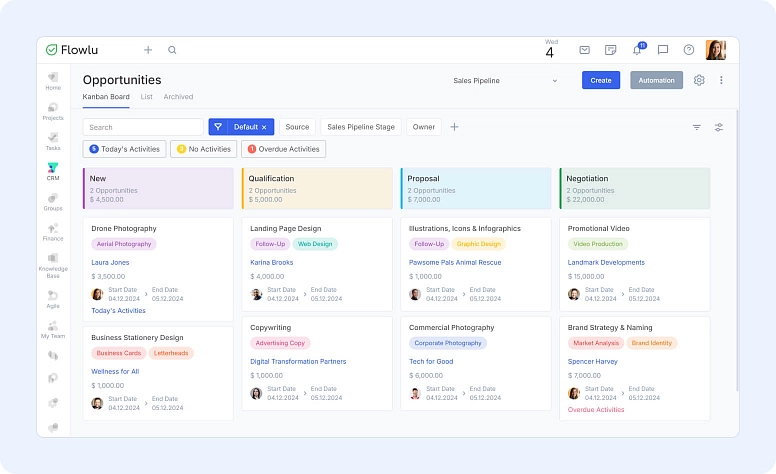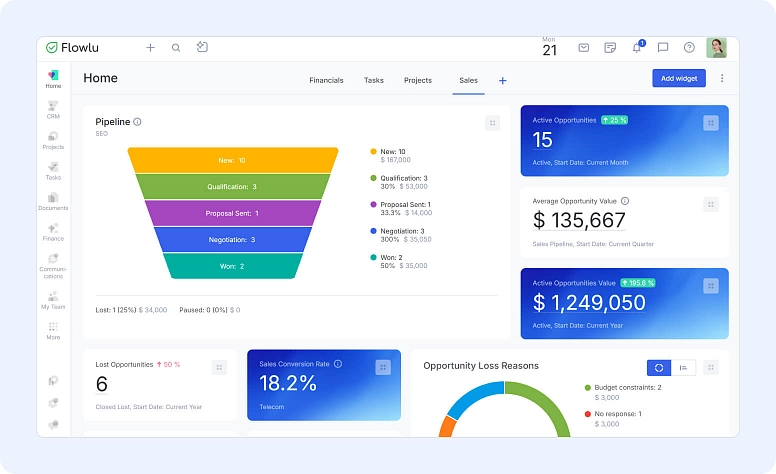Marketing vs. Sales: Why Misaligned Leads Cost the Business More Than You Think
Marketing brings in leads and proudly says, “It’s working!”
Sales takes one look and replies, “These aren’t real buyers.”
And just like that, the blame game begins: marketing says sales can’t close, while sales swears marketing drives junk traffic. In the end, there’s only one really losing: the business that misses its targets and burns through cash.
And this isn’t rare. According to Gartner, the biggest barriers between marketing and sales are:
- Poor communication (45%)
- Incomplete data on leads and customers (43%)
- No clear processes (37%)
In short, the problem usually isn’t “bad leads” or “lazy reps.” It’s the broken connection between the teams.
In this blog post, we will look at where the conflict starts, what it looks like in real life, and how to fix it, so the business can finally get predictable results.
Why Good Leads Go to Waste
At first glance, it’s easy to blame weak marketing or underperforming sales. But the real issue often runs deeper: there’s no shared definition of what a qualified lead actually is.
Marketing measures success by volume: more form fills, more sign-ups, more figures on the dashboard. Sales, on the other hand, focuses on quality: does the person have a real need, a budget, and the power to make a decision? The business, ultimately, stays focused on turning those opportunities into revenue.
If these three views don’t align, there’s only one outcome: conflict and lost profit.
Research from HubSpot shows that companies with aligned marketing and sales teams generate 209% more revenue. Yet, in most companies, those departments operate in silos. Marketing floods the funnel with impressive-looking numbers that don’t convert. Sales rejects most of those leads as “junk” but rarely provides structured feedback. And the business ends up paying for confusion.
Many teams solve this by using one shared system where both sides can track lead sources, conversations, and deal progress in real time. Tools like Flowlu help marketing and sales stay connected instead of working in silos.
Imagine you launch a campaign offering a free SEO audit. The form submissions start rolling in, and marketing celebrates. But when sales follows up, it turns out that most people just want the freebie. Actually, they are not planning to buy anything. As a result, companies end up with a flood of unqualified leads that may look like a win on paper but do not make a single dollar.
What ‘Quality Lead’ Really Means
A qualified lead isn’t just a name and an email. It’s someone who:
- Fits your target audience
- Has a real problem to solve
- Shares up-to-date contact info
- Is at least somewhat ready to talk about solutions
Until the whole company agrees on what success actually looks like and how to track it, the same pattern repeats:
- Marketing hunts for numbers
- Sales weeds most of them out
- The business foots the bill
A qualified lead can still be lost if there’s no structured process in place. Let’s examine where that breakdown typically occurs and how to avoid it.
Why Marketing and Sales Don’t Understand Each Other
Marketing and sales work with the same customer, but they see them through different lenses. And when those views don’t align, conflict is inevitable.
Marketing thinks in terms of the awareness funnel. Their goal is to attract, educate, and warm up potential customers, helping them recognize a problem and see that a solution exists. But not every lead at this stage is ready to buy.
Sales, on the other hand, operates in the sales funnel. They’re focused on ready-to-buy clients — people with budgets, timelines, and clear needs. Everything else feels like noise.
Between those two points lies a long road: awareness of the problem, confidence in the company, handling objections. If that road isn’t covered, a lead that looks like success to marketing will look like wasted time to sales.
What Creates the Gap Between Marketing and Sales
- Different KPIs: Marketers are focused on lead volume; sales managers are focused on conversion and revenue.
- No shared visibility: Marketing doesn’t see what happens after a lead is handed over, while sales doesn’t understand how that lead was generated.
- Broken communication: Teams rarely talk. Marketing doesn’t know how sales handles inquiries, and sales doesn’t share feedback on lead quality.
- No unified strategy: Each team operates at its own pace, chasing different segments instead of focusing on shared priorities and real customer needs.
Together, these gaps turn lead generation into a race for numbers. Both teams are busy, but their efforts don’t add up to meaningful results.
How to Make Marketing and Sales Work Together
To end the conflict, stop looking for someone to blame. Instead, align both teams around a shared goal: revenue and growth.
That alignment starts with a few foundational steps.
Phase 1: Define Success Together
Agree on What a “Qualified Lead” Actually Means
As long as marketing calls every contact a lead and sales only counts the ones ready to sign today, you’ll always get different results. You need to define quality together:
- Who exactly is your target audience?
- What key data should be collected for every lead: contact information, company size, budget, etc.?
- When does a lead show enough intent to be worth pursuing?
For instance, a qualified lead could be someone in your target segment with real contact details and a clear, though not necessarily urgent, business need. Leads outside that scope are early-stage and require further nurturing before reaching the sales team.
With Flowlu, you can create custom fields for each data point, e.g., company size, budget, or decision-maker role. Thus, both teams see the same lead information and track it consistently.
Phase 2: Build Shared Visibility
See the Entire Funnel — Not Just Your Part
Marketing needs to understand what happens to leads after they’re handed off to sales: conversion rates, reasons for rejection, response times. Sales, on the other hand, should have clear visibility into lead sources, marketing channels, and audience segments.
Without that transparency, your teams end up working in the dark.
At Flowlu, for example, we track the complete funnel — from the first touchpoint to a closed deal. We analyze how many leads from each channel convert into paying customers, identify where prospects get stuck, and adjust our strategy as one team, not two separate departments.
Make Feedback a Habit, Not a Meeting
Without feedback, your marketing team has no idea which leads actually help sales, and sales doesn’t know what messaging or materials potential customers need earlier in the journey.
Flowlu’s teams hold weekly syncs to review deals, listen to calls, and analyze common objections. This routine helps them refine scripts, offers, and content together.
Often, the problem isn’t the channel or lead quality, it’s that a sales rep simply doesn’t have the right argument to explain the product’s value.
Respond to Leads on Time
Even the best lead can go cold if your team does not reach out quickly. According to InsideSales, companies that respond within the first five minutes convert leads eight times better than those that take hours, or worse, days.
Most customers contact more than one company, but they tend to go with whoever responds first with a clear, helpful answer. That’s why even promising leads can fade fast if your team isn’t quick to follow up. Flowlu’s automation tools can send instant notifications to sales reps and trigger follow-up reminders, so no opportunity gets missed.
Phase 3: Align Around Results
A Fresh Look Reveals Blind Spots
Once marketing and sales start collaborating closely, the weak spots on both sides become visible fast.
Sales might point out that customers need more case studies on the website or that proposals lack specifics. Marketing might notice where leads drop off before ever reaching a rep.
Sometimes, bringing in an external process audit helps too. An outside perspective can highlight where leads are getting lost long before they reach sales, and what needs to change to make that flow stronger and more consistent.
Shared Goals: The Best Way to End the Marketing and Sales Fight
Even if you fix response times and agree on what makes a lead qualified, the conflict won’t disappear if both teams still chase different goals.
Marketing celebrates when the leads pour in. Sales cheers when the deal closes. But the business only pops the cork for one thing: revenue growth.
As long as marketing focuses on lead volume, sales on speed, and the business on revenue, each team will keep living in its own version of success.
And what is the solution? You should align incentives. Marketing shouldn’t be measured by the number of leads generated, but by how many of those leads turn into real deals.
Sales shouldn’t be measured only by total revenue, but also by how effectively they engage with every lead in the pipeline.
This gives sales manager a fuller view of performance and not just how much they sold, but how they worked:
- How effectively they communicate with clients
- How thoroughly they handle objections
- Whether they follow the first-contact process
- How accurately they log data in the CRM
When you track the entire process instead of just the final numbers, you gain a clear view of what’s working and where bottlenecks occur.
In Flowlu, dashboards and reports show exactly where leads get stuck, and which channels bring the most conversions. That functionality helps the teams to improve the process together.
This mindset removes the “that’s not our problem” barrier. When teams see they’re aiming for one shared goal, not separate scorecards, collaboration naturally replaces conflict.
Final Takeaway
The tension between marketing and sales usually isn’t about lazy reps or bad leads — it’s about broken communication and disconnected systems.
As long as each department has its own metrics and its own truth, the business keeps paying for it in lost deals and missed revenue.
But once you agree on what a quality lead looks like, make the funnel transparent, and align incentives around shared results — everything changes.
Marketing can finally spot the leads that actually matter. Sales connects with buyers who are genuinely ready to engage. And the business achieves what it’s always aimed for: stable and predictable growth.
When marketing and sales stop fighting over credit and start sharing the same scorecard, growth becomes a natural outcome. Flowlu helps teams do just that by giving marketing and sales one shared workspace to plan, communicate, and measure results together.
Start with a few simple points that both teams understand, for example, the right industry, company size, budget, and if the person is ready to talk. Try this idea for a few months and then improve it together using real results.
A short meeting every week is enough. Talk about what campaigns bring good leads, what deals are slow, and what problems customers mention. It’s better to meet often for a short time than to wait too long.
It’s best to use one shared CRM. In Flowlu, for example, both teams can see where a lead comes from, how it moves through the funnel, and what to do next. This helps everyone work with the same information and avoid confusion.


















